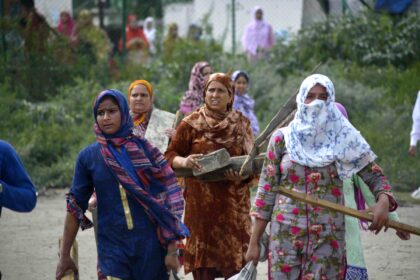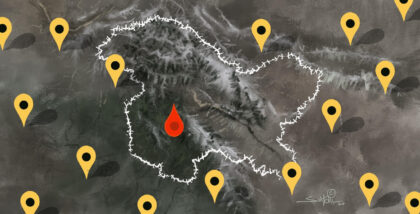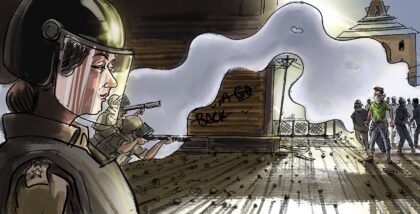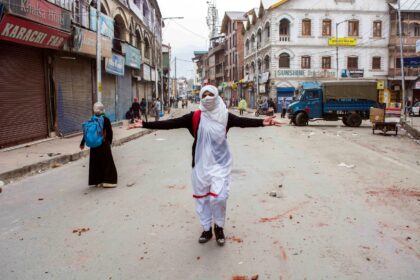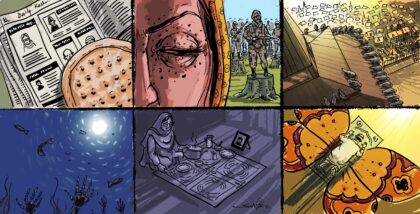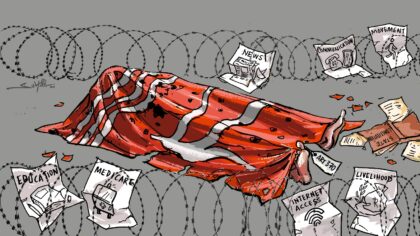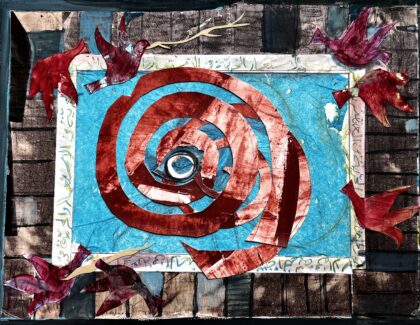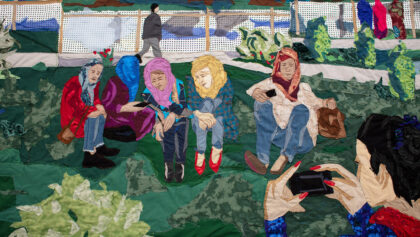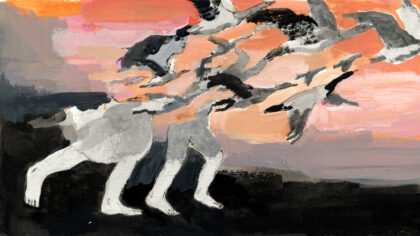 Photo by Masrat Zahra.
Photo by Masrat Zahra.
In October 2019, an old snack seller was making a masaal wrap for a customer on Residency Road in Srinagar, the capital of the disputed Jammu and Kashmir region. Masaal is a favourite Kashmiri snack consisting of boiled chickpeas garnished with radish chutney and served in flat bread called lavaas.
From a tight bundle of newspapers, used notebooks, and magazine pages (third world alternatives to napkins), the old man plucked a local Urdu daily to wrap the masaal for the customer, who happened to be a noted journalist.
“He was about to hand it to me, but something suddenly appeared to have annoyed him,” the journalist told me. “He balled the newspaper up and tossed it away. He said, ‘given what they are publishing these days, the newspapers don’t deserve to be used as wrapping.’”
The old man’s bitterness was understandable. Locally published newspapers had been churning out government statements and filling pages with random text downloaded from the internet: excerpts from Kafka’s Metamorphosis, for example, or a primer titled How to Make Meat Pickle.
If a newspaper is a nation speaking to itself, the one discarded by the street hawker was a defeated nation preaching political quietism to conquered subjects.
*
On August 5, 2019, the Hindu supremacist Indian government abrogated two key aspects of the Indian Constitution, legislation that had previously allowed Jammu and Kashmir to have a separate constitution, make laws independent from the Indian parliament, and bar Indians from either buying properties or taking government employment. The region was also split into two federally-ruled territories—Ladakh, and Jammu and Kashmir—an insult to the former princely state that was virtually independent when India and Pakistan were coming into being.
To forestall revolt, tens of thousands of Indian paramilitary soldiers took over the streets in the Kashmir Valley, a predominantly Muslim area where the possibility of rebellion was high and where a popular anti-India insurgency has been raging for the past 30 years. These reinforcements supplemented about half a million army soldiers, policemen, and paramilitary soldiers already stationed in the region. Telephones and the internet were cut off. About 7,000 people were arrested before and after August 5, including nearly the entire pro-secession and pro-India political leadership.
Like that, the constitution of a place was obliterated by another constitution. Provisions of one of the scrapped laws, known as Article 370, itself were used to nullify it, quite like forcing a man into suicide. Kashmir thus became an annexed territory where all structures, the majority of them Indian-made, were being dissolved so they could fit into the India envisioned by the ruling Bharatiya Janata Party (BJP), whose founding fathers were never comfortable with the unique constitutional status of the only Muslim-majority state.
Before August 5, 2019, Kashmir was a nominally autonomous region. After August 5, it has become virtually a settler colony in the making. Thus now, the media—local, Indian, and foreign—are effectively working in a new ecosystem, in which even the pretenses of freedom have fallen away.
STOP THE PRESS
Kashmiri media had long been the target of Indian governments, especially during the times of political upheaval. But the latest unraveling began a couple of years ago, when I was executive editor of Greater Kashmir, the Kashmir Valley’s largest circulated English daily.
In July 2018, the National Investigation Agency of India asked the paper to furnish the unedited copy of an interview that had been published with a woman resistance leader, Asiya Andrabi. The owner of the newspaper, who is also its editor-in-chief, acquiesced.
The silencing of these largely independent voices paved the way for the arrests, deployment of soldiers, and evacuation of Indian nationals that would come with the August annexation.
Auqib Javeed, the young freelance journalist who had interviewed Andrabi, was questioned for three days at the NIA’s New Delhi headquarters. His phone has not been returned yet despite a court notice. Andrabi’s interview had apparently become an appendage to a “terror-funding” case in which dozens of resistance leaders and activists would be arrested or interrogated. Andrabi is one of the accused.
Handing over the unedited copy of the interview exposed the freelance reporter to the Indian police system, where a prolonged prosecution often becomes punishment. There was a realization at the newspaper that we had been marked precisely for such a punishment, and the pressure tactics wouldn’t stop here. The immediate fallout? Self-censorship.
The boss began to read every last line of major stories of the day. He would, of course, read between the lines, too. Anything that could be misread by the Indian government as pro-freedom would be tweaked. The newspaper’s style sheet gradually changed to suit government sensibilities. Stories that deserved prominent display were relegated to inside pages. Several regular columnists were asked to go slow on Kashmir-centric issues and later requested to stop writing altogether.
“How difficult is it to get your head around the fact that the situation is scary? Kashmir is North Korea,” the boss told a copy editor one day.
In March of last year, local government advertisements were pulled from Greater Kashmir and later also from its Urdu publication, Kashmir Uzma. Ads were also pulled from Kashmir Reader, an English daily that was banned for three months during the 2016 revolt triggered by the killing of an iconic rebel commander, Burhan Wani (I was its editor then).
The NIA summoned the owners of both newspapers to New Delhi in July 2019 and questioned them for several days. What I learnt was that the exhaustive and exhausting questioning had a dispiriting effect on both.
At Greater Kashmir, it soon became clear that the management of the paper wanted me, along with the other two top editors, out. We were told that because of the company’s dwindling finances, they couldn’t continue with us “on a regular basis,” and instead offered us an honorarium if we agreed to work from home. We politely refused the offer and resigned.
The silencing of these largely independent voices actually kickstarted the process that would culminate in the demographic invasion. They paved the way for the arrests, deployment of soldiers, and evacuation of Indian nationals that would come with the August annexation.
After August 5, the two newspapers bore all the signs of conquered entities. Editorials and opinion pieces were missing. A former government information department bureaucrat wrote the only opinion in Greater Kashmir related to the epochal August political developments. The article mocked critics of India’s actions.
The rest of the 170 odd newspapers and magazines published from Kashmir needed no arm-twisting to fall in line.
I learned through the journalistic grapevine that the owner of another English daily told his editorial staff that those who want to practice journalism should sit at home.
What did they do if they were not practicing journalism? Practicing the art of survival, perhaps. But the new political order is geared towards making survival difficult for anyone who does not conform. All forms of dissent have been criminalized. And the scope of defining dissent has been vastly widened.
In February 2020, my friend and noted journalist Naseer Ahmad Ganai was booked under an anti-terror law for reworking the statement of a banned secessionist organization, the Jammu and Kashmir Liberation Front (JKLF), into a news report. He was questioned for nearly six hours at a police center notorious for torturing civilians and insurgents. Before the Narendra Modi-led BJP came to power, several Indian governments had held back channel talks with the JKLF, which launched the armed insurgency in 1990 but was the first to give up arms in 1994 for a peaceful struggle.
ESCALATING TACTICS
Viewed historically, the current crackdown on the media in Kashmir is the logical denouement of policies enacted by many previous Indian governments.
During the 2002-2008 period, when India’s supposedly liberal Congress party was in power, police filed about a dozen cases against Greater Kashmir. Government advertisements in the paper were pulled after bold coverage of a mass peaceful uprising. Reporters and photojournalists were beaten while covering events.
Both conformity and defiance come with a very high cost.
Oppressive though it was, however, the system then differs with that of the current regime in terms of the degree of suppression and the articulation of Indian nationalistic claims over Kashmir.
For example, during the Congress regime, you could be labeled “anti-national” for a report on human rights abuses by Indian forces or for writing a profile of a Kashmiri university teacher who had picked up arms. Today, you could be booked under an anti-terror law on charges of “glorifying militants.” Like many things, “glorifying militants” is undefined. What it means, however, can be gauged from what newspapers have stopped writing about militants. For example, Kashmiri newspapers regularly wrote profiles of dead militants: how they embraced arms after giving up studies in engineering or careers in academics, how relentless persecution by police forced a youngster to pick up arms. They would report on the harassment of militants’ families. No more. The contemporary story of media repression in Kashmir is, therefore, of one system outperforming its predecessor.
The Congress government focused on management. An aggrieved newspaper owner could wriggle his way out of an acute bout of state pressure by meeting a few politicians and intelligence officials—playing the good cop. He could mount a legal defense in the courts, which were relatively freer. Today, for the Kashmiri media, both conformity and defiance come with a very high cost. Recently, the Indian Supreme Court virtually abdicated its role while hearing a petition seeking restoration of high-speed internet—snapped last August—in Kashmir. It asked India’s home ministry, which had imposed the ban in the first place and was defending it in the court, to simply “review” the policy. The ban remains in place.
NARRATIVE WAR
The Congress party committed the original sin of manufacturing a pernicious Kashmir master narrative, the one in which Kashmir’s struggle for political rights was labeled as a Pakistan-sponsored proxy war the moment it started. Eight million Kashmiri Muslims effectively became zombies manipulated by the Pakistani state. These people had not been wronged and therefore had no reason to articulate their demands. By extension, the narrative became the touchstone for describing people and institutions broadly as patriots and traitors. Thus, Arundhati Roy is a traitor while a former army officer advocating rape of Kashmiri women on national TV is a patriot.
A counternarrative that could somehow disassociate Kashmiris from their passionate pursuit of freedom became the holy grail of liberal media, right-wing think tanks, and army generals.
This narrative, a staple for much of the Indian media, posited that Kashmiri young people were picking up arms because of rampant unemployment (an early theory during non-BJP governments) or radicalization (the reigning thesis because when some men gave up secure jobs to join the militancy, the previous one looked tenuous). The narrative denied Kashmiris any agency. It posited that youths were protesting against India and clashing with its soldiers because resistance leaders paid them seven dollars a day. Journalists who covered rights abuses by Indian forces were labeled as Pakistani agents.
Besides tarnishing a genuine struggle for political rights, the Congress party’s Kashmir propaganda ended up radicalizing hundreds of millions of Indians who voted Narendra Modi into power because he channelized this narrative into a civilizational battle, the one in which all Muslims are primordial villains.
A counternarrative that could somehow disassociate Kashmiris from their passionate pursuit of freedom, therefore, became the holy grail of liberal media, right-wing think tanks, and army generals. It was tried through the Indian army’s Operation Goodwill, which involved taking Kashmiri kids on tours of Indian cities, or opening “skill development centers” and building mini hydropower projects. The liberal media TV channels would occasionally host resistance leaders or publish writings by Kashmiri intellectuals. Until last August.
Realizing that the Kashmiri hearts and minds might never be won, the Hindu supremacists dropped the niceties of the previous quasi-militarized rule. Journalist Qazi Shibli was flown from Kashmir to the Indian state of Uttar Pradesh, about 800 kilometers away, in the run up to the August 5 crackdown. His family learnt of his whereabouts a month later. He was released on April 25 of this year. On April 18, a young woman photojournalist, Masrat Zahra, was booked under an anti-terror law for posting on social media photographs that “glorified anti-national activities” and “anti-national posts with criminal intention.” These were photographs that had been published previously.
In our new reality, the old methods have not been eschewed altogether. For example, advertisements were restored to Greater Kashmir a month after the abrogation of special laws because the paper had stopped rubbing the state the wrong way. No local newspaper did. Today, all newspapers in Kashmir, from high-circulation outlets to one-man broadsheets, look nearly the same, like assembly line products.
DESOLATION CALLED PEACE
The local media in Kashmir, the most accessible and potentially effective, is comatose. It does what keeps it ticking. A delegation of local newspaper owners and journalists were “invited” to a meeting with foreign envoys India flew to besieged Kashmir in January this year. One journalist reportedly told the envoys that Modi deserved a Nobel Prize, and another said the internet blackout had actually boosted circulation of his newspaper.
Two reporters of an English daily told me they were not using office broadband because the management had asked them to sign an undertaking, drafted by the government, that the internet would not be misused, and, in case the government asked, the organization would hand over computers to police for scrutiny.
“Contested territory” and “India stripped it of its semi-autonomy” are the last things Indians want to hear about Kashmir.
The majority of the Indian media, as in the past, works like an extension of the Indian state when it comes to Kashmir. When the special laws were abrogated, the majority of Indian media outlets parroted the state line. One Indian channel regularly hosts Sushil Pandit, who has said that the lives of Kashmiri Muslims should be made difficult in India. A few who seemed to have been airlifted to Kashmir as cheerleaders reported on how India’s national security advisor Ajit Doval drove to Shopian, among the most rebellious districts in Kashmir, and had tea with a few civilians who later said they had been tricked into believing that a local official was coming to meet them. The orchestrated report was meant to tell Indians that Kashmiris were happy with the loss of their autonomous political status.
This leaves the foreign media and a few independent Indian news outlets as islands of hope. But the Indian government has made it difficult for foreign correspondents based in New Delhi to cover Kashmir. On August 1, 2018, Annie Gowen, then the Washington Post’s India bureau chief, was denied permission to report from Kashmir; many others would have the same experience in the months to come.
Foreign journalists didn’t stand a chance anyway because India didn’t allow its own parliamentarians to visit Kashmir after the August 5 decision. Indian or Indian-origin foreigners and Kashmiri journalists working for the foreign media were the only ones allowed to report from Kashmir during the military and communications siege.
Last August, the Indian home ministry deemed an exclusive BBC report on Indian police firing live ammunition and shotgun pellets into a massive demonstration in Srinagar “fabricated.” The BBC refuted the Indian charges by broadcasting raw footage of the protesters running for their lives.
In May 2020, the Hindu nationalist government and millions of its supporters were outraged when three Associated Press photographers won the Pulitzer Prize in feature photography for their Kashmir coverage during the military and communications lockdown.
More than the photographs, many Indians begrudged the citation that accompanied the trio of two Kashmiri Muslims and a Hindu. They were awarded “for striking images captured during a communications blackout in Kashmir depicting life in the contested territory as India stripped it of its semi-autonomy.”
“Contested territory” and “India stripped it of its semi-autonomy” are the last things Indians want to hear about Kashmir.
THE NEW REALITY
What happens to the media in Kashmir will depend on how the Indian state proceeds with its demographic plans.
When a language loses its primacy, anything published in it becomes marginal.
The full import of this legal-administrative-security onslaught will unfold gradually. For example, Urdu has been the official language of the state since 1889. It is likely to be replaced with Hindi or English. This process is unfolding already. Billboards in Hindi publicizing the government of India’s flagship programmes, often featuring pictures of Narendra Modi, have been erected at key spots in Srinagar. What is the point of such declarations when hardly anyone can read them? The message appears to be: “get used to the new reality.”
“When a language loses its primacy,” an editor of an Urdu daily told me, “anything published in it becomes marginal.”
On June 2, the government laid out a media policy 2020 that “attempts to thwart misinformation and fake news and tries to develop a mechanism that will raise alarm against any attempt to use media to vitiate public peace, sovereignty and integrity of the country.” What will this alarm look like? What qualifies for “vitiating sovereignty and integrity of the country”? One of my journalist friends likened it to Ku Klux Klan laying down journalism rules for Black people.
But despite oppression and the looming threat of persecution, the will to tell the Kashmiri story survives. In the 1990s and 2000s, a generation of Kashmiri journalists, most of them first-generation literates, embodied the rebellious spirit of the times and managed to convey to their own people and the larger world tales of soul-wrenching oppression and inspiring resilience. Today, when reporting a straightforward news story is no less than speaking truth to power, a younger generation of spirited journalists has stepped in. When the Indian state blocked all forms of communications last year, these journalists smuggled stories on flash drives out of the besieged valley. If they don’t find a mainstream outlet for a story, they make sure it gets heard through other means. Still, telling stories is getting harder by the day.
Today, the most pervasive feeling in Kashmir is that of despair intensified by the indifference of the world. The issue of the media in Kashmir, a place already being talked of as Palestine in the making, cannot be divorced from the larger political circumstances. We are fully aware of how institutions work in colonial societies and how stunted institutions lead to the decay of a people. How authoritarian regimes can legalize oppression. In the worst-ever phase of their tormented history, Kashmiris are looking toward the world for deliverance.
